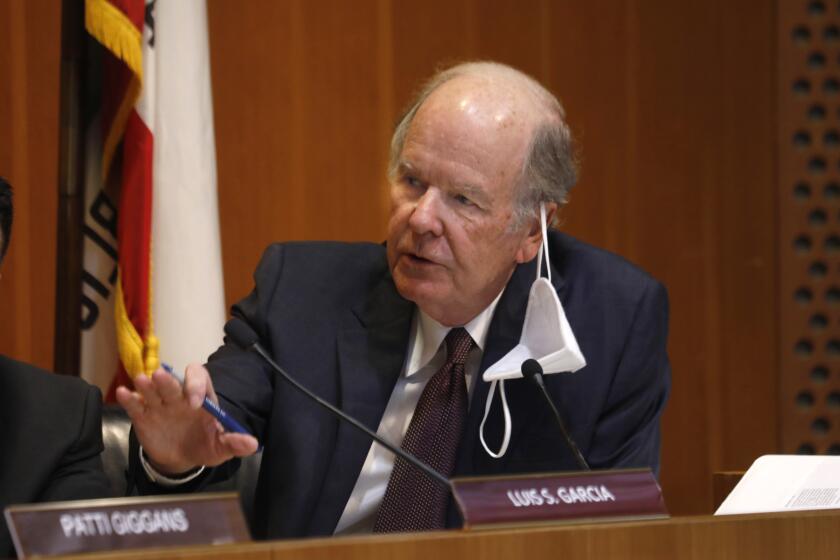Professor Shreds L. A.’s Stereotype
- Share via
Leave it to a New Yorker to pronounce that Southern California is not unusual anymore. That seeming contradiction comes from an urban historian, Kenneth T. Jackson of Columbia University, a visiting professor at UCLA.
The stereotype of the Los Angeles area as an infamous sprawling maze--with its residents driving into town from a miles-away, rambling ranch house with a multi-car garage--is pretty much outdated, Jackson declares.
“When cities were building, 75 to 100 years ago, California was a leader in showing the way toward a suburban way of growth. At the end of the rainbow, there was a house with a palm tree, driveway and automobile.
“What is important and unusual about California now is that it’s beginning to show the way toward a new urbanization and high density,” he said.
He went on, puncturing the stereotype:
“In 1980, the average American traveled 9.2 miles to work. In 1986, the average Southern Californian traveled less than 10 miles to work,” and that means that “Southern California is not unusual anymore.
“In terms of per capita gas consumption, an index of how dependent we are on our automobiles, California is just about exactly at the national average--532 gallons per person--and way below Florida and Texas. . . .
“In the number of automobiles per 1,000 people, California is below the national average. Illinois and Florida are at the top.
“In summary, California has been a leader twice,” he said, leading the way out of town and now leading everyone back into the urban area.
He lectured on the subject, “The Past and Future Metropolitan Sprawl in California,” at a neutral site last month, at Stanford University, under sponsorship of the history department and American studies and urban studies programs.
Californians, on the whole, he said, are beginning to live closer to work, home ownership rates are falling and dense, walled cities in the medieval pattern are dotting more rural landscapes. He cited some examples:
The Irvine Ranch, the Palm Springs-Rancho Mirage-Indio areas in the Southland, and the eastside of San Francisco Bay where both Contra Costa County and the Oakland-Berkeley corridor contain new high-density developments.
Jackson labeled such new areas as being part of a “multi-nucleated structure.”
“You see the roofs on the hill--many of them red, like Stanford--all close together. You can barely make out the streets. All around, just beyond the wall are open fields--not hot dog stands, not Holiday Inns, not the American suburban village.
“In a way, the city used to represent security. You went within the wall to be safe from robbers and highwaymen. A hundred years ago, we reversed that, and the city came to represent danger to us and the suburbs (represented) safety.”
During the next 25 to 50 years, he professed, suburbs will continue to grow “but the explosive change is over.” Historically, highway construction drove suburban growth but “now it is (an) exodus of employment,” he said, citing Contra Costa County’s Bishop Ranch as one of the nation’s biggest office complexes.
But, he added, there will also be a gradual return to the cities, resulting in gradual, relative change in land values favoring the land--and homes--closer to workplaces and transit facilities.
And for those who have property near proposed/planned rapid transit systems--attention Metro Rail opponents/proponents--land values will increase and land inaccessible to mass transit will drop relatively, he said. “It’s no revolution. It will take a long time.”
He noted that some futurists, considering the impact of the computer age, envision an America of even more sprawling cities with people doing more work at home and electronically shopping from their homes.
“A hundred years ago, when the telephone was about as new as the computer (is today), the futurists predicted that cities were obsolete--that we no longer needed face-to-face communication for exactly the same reasons the futurists argue . . . now.
“In retrospect, we know from architectural historians that the telephone, in conjunction with the steel frame skyscraper elevator, in fact almost made the big central business districts possible.”
Jackson is sure we are not going to stay at home to work. There is, he said bravely, “too much togetherness in most marriages, anyway.”
More to Read
Sign up for Essential California
The most important California stories and recommendations in your inbox every morning.
You may occasionally receive promotional content from the Los Angeles Times.













